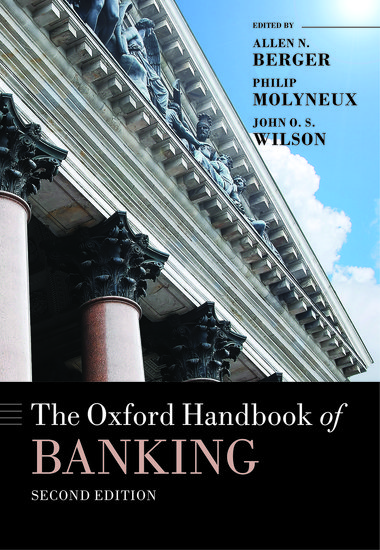The Oxford Handbook of Banking strikes a balance between abstract theory, empirical analysis, and practitioner and policy-related material. Aloysius Chia thinks the Handbook is erudite and well-suited for people wanting to glean a deeper understanding of banks in general and how they work.
 The Oxford Handbook of Banking Second edition. Allen N. Berger, Philip Molyneux, John O.S. Wilson (eds.). Oxford University Press. November 2014.
The Oxford Handbook of Banking Second edition. Allen N. Berger, Philip Molyneux, John O.S. Wilson (eds.). Oxford University Press. November 2014.
The Oxford Handbook of Banking provides a comprehensive, erudite overview of banks, the banking industry and banking in the economy. In this brief review, I focus on three chapters – complexity and systemic risks (Chapter 4); systemic risk from a macroeconomic perspective (Chapter 27); and the management of risks of banks in the banking industry (Chapter 7).
Since, the financial crisis in 2008, a large number of economists, sociologists and commentators have scrutinised the banking industry. The large bail-outs of Bank of America and AIG, and the losses incurred with the bankruptcy of Lehman Brothers have brought close attention to the internal processes and external structure of banks. Why was it that the failure was so large and unforeseen, and how can such large entities be regulated?
In Chapter 4, “Complexity and Systemic Risk”, an overview of banks since the financial crisis is given full treatment. The question of how to regulate banks that are ‘too big to fail’ has emerged as one of the most pressing issues since the banking crisis.Some would think that given the scale of the crisis that multinational banks that take part in a broad range of banking related activities (Securities, Bonds, Foreign Exchange etc.) would be reduced in size, as part of a larger trend of market self-correction. On the contrary, the authors show that since 2007 to 2012 the 13 largest banks have increased their subsidiaries by 23% while reducing their size by 5% on average.
Part of the problem with regulating large banks, such as HSBC, Deutsche Bank and JP Morgan Chase, is that they are dual natured entities: they have public services but are profit driven. Traditionally, banks serve as intermediaries. Depositors put their money for safekeeping, banks then pay an interest, and subsequently lend to others at a profit. With the loosening of boundaries between savings and investment banks since the 1980s, banks have increasingly used sophisticated tools and sold complex products that are difficult for regulators to track and understand.
 Royal Bank BCE. Photo Credit: Reto Fetz. CC-BY-NC-SA.
Royal Bank BCE. Photo Credit: Reto Fetz. CC-BY-NC-SA.
One problem lies in the variations of information and cognitive focus between various actors that are inherent within the structure of banks. The disparate number of Special Investment Vehicles (SIVs) and subsidiaries create asymmetric information networks within and amongst banks. For instance, top level managers differ in their approach from lower level managers, who tend to be more rent seeking than others. Separating risky subsidiaries from the group and preventing costs of financial failure from spreading is just some of the many strategies banks use to control risk.
Yet, despite internal control measures, it is usually hard to separate one subsidiary from another, since counterparties to securitised products are intricately bound to others, whom are then linked further to other parties so much so that they are bound by their balance sheet. It is often hard to know the asset end of the securitisations and connect them easily to how they are traded in the market.
Chapter 27, ‘Systemic Risk in Banking’, adds further to the above chapter and looks at banking from a broader, macroeconomic perspective. Much focus has been placed in the large scale effects of crisis on banks on the broader economy. Since banks are important intermediaries in the economic system, fallout on a large scale can lead to a shutdown in the economy. This chapter highlights some theories of systemic events, such as ‘self-fulfilling’ ones, in which signals about bank health lead to depositors acting in ways that affect banks so that even solvent banks are affected, as an example of the various ways in which there could be a breakdown in the financial system.
This chapter on risk in relation to the macro-economy is extremely insightful and interesting. The recent crisis shows that confidence about the financial system is just as important for the sound working of the financial system as much as ‘hard’ microeconomic data. Regulators such as the Bank of England have had to take into account a ‘macro-prudential’ perspective in decision-making, paying attention to such forces when adopting decisions about the economy as a means of maintaining stability.
Other useful parts in the chapter about the elements of contagion and market fluctuation give a nuanced account of systemic risk, which oftentimes are intricately connected to the outline of banking networks. An especially important factor is evidence of such risks in actual market processes or how banking activities are mapped or reflected in the real economy, which this chapter addresses.
Finally, Chapter 7, ‘Risk Management in Banking’ looks at the various ways in which banks deal with complex products and the tools available to them that manage risk in their operations. A fascinating account is when the author describes the history of how JP Morgan tried to come up with internal ways to measure risk using a tool called ‘RiskMetric’ to deal with capital adequacy requirements, to deal with the fact that it was a bank that had both savings and investment functions (that investment only banks were not liable to at that time). As highlighted by the author, this model was based on assumptions not supported by empirical evidence and data, yet widely adopted by the industry and tacitly allowed by regulators.
Other methods have been adopted as well, and the parts such as options, swaps and futures present an eye-opening and somewhat unsettling account of the tools used in the modern banking industry. Eye-opening because this is what a substantial part of the modern bank consists of, which many outside of banking are unaware; unsettling because one can see the inherent disjunctions and hidden risks that may be involved in such complex ways of managing money.
But there are many other considerations as well. Other chapters in the handbook include chapters on Shadow Banking, Liquidity, Consumer Lending, Competition, Technological Change and Banking Globalization, all of which are thoroughly researched and useful in gaining insights into the banking industry. They are well-structured and delve deep enough without being overly-detailed, and will suit all those who would like to glean a deeper understanding of banks in general and how they work.
This review originally appeared at the LSE Review of Books.
Featured image credit: We Are Women (Creative Commons: BY-NC-SA 2.0)
Please read our comments policy before commenting.
Note: This article gives the views of the authors, and not the position of USApp– American Politics and Policy, nor of the London School of Economics.
Shortened URL for this post: http://bit.ly/1KdevpS
——————————————–
Aloysius Chia – LSE Sociology
Aloysius Chia is currently pursuing a Masters in Sociology at LSE, with interests in economic sociology, economic systems, technological change, and the transformation of economic life in modernity.






